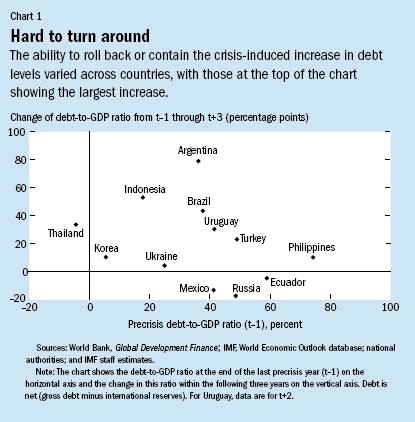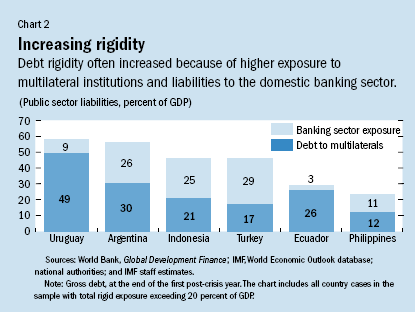
Typical street scene in Santa Ana, El Salvador. (Photo: iStock)
IMF Survey: How Sovereign Debt Evolves in Crises
February 26, 2007
When a financial crisis hits a country, the first concern is to limit the damage.

Customers outside bank in Buenos Aires during Argentina's 2001 financial crisis, one of 12 crises studied in paper (photo: Rickey Rogers/Reuters)
Postcrisis blues
Typically, the official community has provided the affected countries with sizable financial assistance to support economic reforms designed to ease liquidity pressures and restore confidence. In some countries, the authorities have extended substantial support to financial institutions to limit the fallout on the domestic banking system. Such programs, it is broadly agreed, have been reasonably successful in restoring confidence and in helping crisis countries make progress toward macroeconomic recovery.
Highlights
The issue: Emerging market countries tend to exit from episodes of financial crisis with heightened debt-related vulnerabilities, which may leave their economies exposed to the risk of recurrent distress.
Bottom line: Crises typically cause an increase in public sector debt ratios, while the proportion of debt outstanding to multilateral creditors and the domestic banking system rises, creating a more rigid debt structure—in the sense that a higher share of sovereign debt becomes less amenable to a restructuring in extreme cases where no other feasible set of policies exists to restore debt sustainability.
Policy implication: Policymakers should pay increased attention to debt management issues and discourage a large buildup of domestic banks' exposure to public sector debt.
But once the immediate crisis is over, the fallout can linger for some time, particularly if the government has taken on large new liabilities to get through the crisis, creating new vulnerabilities. When these vulnerabilities persist, they can undermine a country's ability to exit from a crisis on a durable basis and can leave the economy vulnerable to recurring distress.
Therefore, how a country gets out of a crisis matters. A recent IMF study examined the extent to which changes in a country's debt profile during times of financial distress can affect its future financial vulnerability. The findings, from a study of 12 emerging market crises, are relevant to how future financial crises are handled. The study looked at crises in Argentina (2001), Brazil (1998), Ecuador (1999), Indonesia (1998), Korea (1997), Mexico (1995), the Philippines (1998), Russia (1998), Thailand (1997), Turkey (2001), Ukraine (1998), and Uruguay (2002).
Debt proves difficult to reduce
The study shows that the debt ratios of many of the countries in the sample increased as a result of the crisis and proved difficult to reverse in its wake. The net debt-to-GDP ratio (gross debt adjusted for the central bank's international reserve holdings) increased, on average, by 32 percentage points in the first two years following the onset of the crisis, reflecting mainly the effects of a sharp depreciation of the exchange rate. But after two more years, this ratio still exceeded the precrisis level by 21 percentage points.

This pattern of persistently high debt levels was most pronounced for Argentina and Indonesia, where the public debt-to-GDP ratio three years after the end of the crisis was more than 50 percentage points of GDP higher than it was before the crisis (see Chart 1). Although the debt dynamics were less dramatic in Brazil, Thailand, Turkey, and Uruguay, debt ratios still exceeded their precrisis levels by more than 25 percentage points of GDP.
In many of these countries, the typically severe impact of exchange rate depreciation on the external component of sovereign debt was reinforced by a substantial increase in domestic debt following the crisis notably because of a temporary loss of access to international capital markets and, in some cases, because of debt issued to recapitalize banks in the context of efforts to address weaknesses in the domestic financial system.
Only three countries—Ecuador, Mexico, and Russia—succeeded in fully reversing the initial increase in their debt ratios within three years of the crisis. Their economic adjustment efforts were helped greatly by a favorable trend in key export prices. In Ecuador and Russia, a comprehensive restructuring of sovereign liabilities, including those held by official and private creditors, was also a contributing factor.
More rigid debt structures
The study showed heightened rigidity in some countries' postcrisis debt structure—the result of a sharp increase in the claims of multilateral institutions, which enjoy a de facto senior status over other unsecured claims, and in those held by domestic financial institutions.
Sovereign liabilities to multilateral institutions increased, on average, by 4.3 percentage points of precrisis GDP in the two years following the onset of the crisis, reflecting the substantial financial assistance provided by these lenders. Combined with more modest growth in the exposure of other creditor groups, the result was that senior multilateral debt as a share of total medium- and long-term external debt rose from an average of 24 percent to 33 percent in the crisis year alone and stayed at that level for the following five years.
Debt rigidity also increased because of a significantly higher exposure of a fragile financial sector (notably banks) to the sovereign. Although such claims rose sharply in about half the countries in the sample, bank exposure to the sovereign after the crisis was particularly high in Argentina, Brazil, Indonesia, Mexico, and Turkey. In these cases, it still exceeded 15 percent of GDP in the third postcrisis year and often represented a large share of total bank assets.

Rigidity in the debt structure could exacerbate countries' vulnerabilities to the extent that it makes it more difficult for the sovereign to achieve a sufficient reduction of its debt in extreme circumstances where there is no feasible set of policies to restore debt sustainability without a debt restructuring. It is not surprising, then, that the substantial size of rigid liabilities relative to some countries' GDP initially increased concerns about postcrisis debt vulnerabilities (see Chart 2).
Debt levels, however, eventually declined—even if, in some cases, only with considerable delay—as a result of policy adjustment, a favorable external environment, and, in some cases, a restructuring of the sovereign's liabilities. The issue of debt rigidity thus became less critical.
It is difficult to draw strong conclusions about the other changes in sovereign debt structures because of data limitations regarding the maturity and currency composition of domestic public debt. Evidence from a limited number of countries suggests, however, that governments generally faced significant difficulties in reducing their short-term debt and/or foreign-currency debt following a crisis, and that, as a result, rollover and currency risk did often remain at a significant level.
Policy implications
Countries are likely to emerge from a period of financial distress with a debt profile that is weaker than it was before the crisis. There is, however, a greater cause for concern when crisis-induced changes to the sovereign's debt level and profile significantly increase debt-related vulnerabilities and show signs of persistence.
How can countries mitigate the effect of future crises on the level and structure of their debt? Recent crises have shown that improvements in macroeconomic policy responses combined with a strengthening of the institutional environment may help. In this context, the recent shift away from fixed exchange rate regimes and toward more flexible arrangements could limit the scope for large and abrupt changes in exchange rates and their impact on debt levels that plagued countries forced to exit from currency pegs.
Many emerging market countries are also continuing to strengthen debt management by developing domestic debt markets and broadening the sovereign's creditor base. Despite welcome improvements, policymakers should continue to focus on reducing rigidity in the sovereign's debt structure as part of a comprehensive crisis prevention strategy. Such a strategy may include regulatory action aimed at discouraging a large buildup of domestic banks' exposure to the sovereign.







